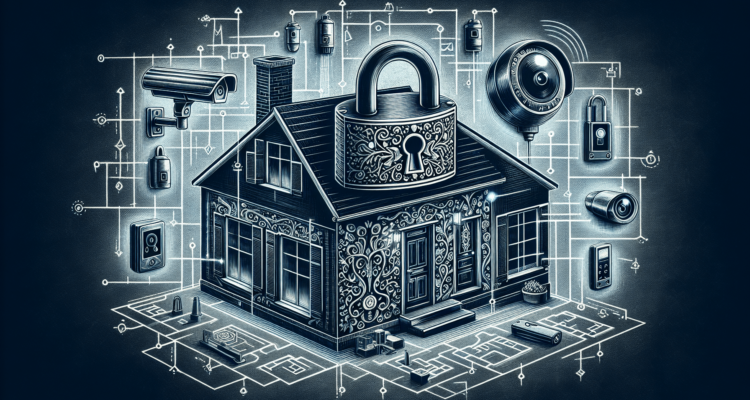Smart Home Security Audit
Embarking on a journey to secure your home and safeguard your loved ones has never felt more reassuring with the Smart Home Security Audit. This meticulous examination scrutinizes every aspect of your dwelling to unveil and fortify any weaknesses, ensuring your sanctuary remains inviolable. Through a blend of human insight and cutting-edge technology, the audit offers personalized strategies that not only enhance your home’s security but also integrate seamlessly into your lifestyle. By prioritizing proactive prevention and empowering you with comprehensive insights, you gain the peace of mind and the freedom to live your life, confident in the security of your home and the protection of your family.
Understanding Smart Home Security Audit
The concept of a smart home security audit
A smart home security audit is an essential process that involves a thorough examination of your smart home ecosystem to ensure all devices and networks are secure against threats. It’s like giving your home’s digital security a comprehensive health check-up, identifying potential vulnerabilities before they can be exploited. This audit helps to reveal how well your smart devices work together in protecting your privacy and security.
Importance of security in smart home ecosystems
Security in smart home ecosystems is crucial as it not only protects your physical possessions but also safeguards your personal information from unauthorized access. Given that smart homes operate through interconnected devices, a breach in one device can potentially compromise the security of the entire ecosystem. That’s why maintaining an impenetrable security system is imperative to enjoy the conveniences of a smart home without putting your safety at risk.
Identifying common vulnerabilities in smart homes
Common vulnerabilities in smart homes often include weak passwords, outdated firmware, or unsecured network connections. These weak spots can serve as gateways for hackers to infiltrate your home network, gaining unauthorized access to your personal information, or taking control of your smart devices. Recognizing these potential threats is the first step towards securing your digital fortress.
Preparing for Your Audit
Creating a comprehensive checklist of smart devices
Begin by compiling a detailed checklist of all smart devices in your home, including thermostats, locks, cameras, and voice assistants. This inventory will help you keep track of updates and assess each device’s security features.
Understanding the network infrastructure of your smart home
Gain a clear understanding of your smart home’s network infrastructure. This includes recognizing how devices are connected, whether it’s through Wi-Fi, Bluetooth, or a hub. Understanding how your network is organized will assist you in identifying potential points of entry that need securing.
Setting audit objectives and scope
Define what you aim to achieve with the audit. Are you checking for vulnerabilities, verifying compliance with security standards, or both? Clearly outlining your objectives and the scope of your audit will streamline the process, ensuring you cover all necessary areas without getting sidetracked.
Assessing Physical Security Measures
Evaluating the strength and security of doors and windows
Inspect the physical entry points to your home, such as doors and windows, to evaluate their strength and security. This includes checking the condition of locks, the durability of materials, and the presence of any smart security systems installed to safeguard these entrances.
Reviewing the placement and effectiveness of security cameras
Assess the strategic placement and effectiveness of security cameras around your property. Ensure they cover all vital areas, provide clear feeds, and are positioned out of easy reach to prevent tampering.
Inspecting outdoor lighting and potential hiding spots
Examine your property’s outdoor lighting to ensure it adequately illuminates potential hiding spots where intruders could lurk. Well-lit exteriors can significantly deter unauthorized entry.
Evaluating Network Security
Assessing the security of your Wi-Fi network
Check the security settings of your Wi-Fi network. It should be encrypted with a strong password and, ideally, hidden from public view. Regularly updating these settings increases your network’s resilience against cyber threats.
Checking for firmware updates on all devices
Ensure all smart devices are running the latest firmware versions. Manufacturers often release updates that patch security vulnerabilities, so keeping your devices updated is crucial for maintaining their defense mechanisms.
Understanding the risks of default settings and how to change them
Familiarize yourself with the risks associated with keeping default settings on devices, particularly default passwords. Learn how to customize these settings to enhance security, making it more difficult for unauthorized users to gain access.
Device Security Analysis
Investigating the security features of smart locks
Examine the security features of your smart locks, such as encryption levels and the ability to track and control access remotely. Ensure these locks are resilient against hacking attempts.
Reviewing the data protection measures of smart cameras
Analyze how your smart cameras store and transmit data. Data should be encrypted, and any cloud storage used should comply with high standards of data protection to prevent breaches.
Ensuring voice assistants have adequate privacy settings
Voice assistants should be configured with privacy in mind, including disabling continuous listening and reviewing the data collection practices of the manufacturer to ensure it aligns with your privacy expectations.
Software and Application Security
Checking for updates and patches
Regularly check for and apply software updates and patches for all your smart devices and their corresponding applications. These updates often contain crucial security improvements.
Reviewing permissions and access controls
Examine the permissions granted to each smart device and its app. Limit these permissions to only what’s necessary for the device to function correctly, minimizing potential data exposure.
Assessing data sharing and storage practices
Understand the data sharing and storage practices of your smart home devices. Ensure that you’re comfortable with how and where your data is stored and who has access to it.
Identifying and Managing Vulnerabilities
Using vulnerability scanners for smart devices
Utilize vulnerability scanners designed for smart home devices to automatically detect weaknesses in your network. These tools can provide insights into potential areas that require attention.
Prioritizing risks and planning mitigations
After identifying vulnerabilities, prioritize them based on the level of risk they pose. Develop a plan to mitigate these risks, starting with the most critical vulnerabilities.
Developing a response plan for potential security breaches
Prepare a response plan in case of a security breach. This includes steps to isolate affected systems, assess and limit damage, and notify any necessary stakeholders or authorities.
Enhancing Security with Automation
Utilizing automated security alerts and responses
Implement automated security alerts and responses in your smart home system. This can help in immediately identifying and responding to potential security incidents without delay.
Leveraging AI for predictive security measures
Consider using artificial intelligence (AI) to predict and counteract potential security threats. AI can analyze patterns and predict suspicious behavior, enhancing your home’s defense system.
Automating software updates and password changes
Set up automation for routine tasks such as software updates and password changes. This ensures that your system remains up-to-date with minimal effort on your part.
Education and Best Practices
Training family members on smart home security
Educate all family members about the importance of smart home security and safe practices, ensuring everyone understands their role in maintaining the security ecosystem.
Establishing safe usage guidelines
Create guidelines for the safe usage of smart home devices. This should include best practices for creating strong passwords, managing device settings, and recognizing phishing attempts.
Staying informed about the latest security threats and trends
Stay informed about the latest security threats and trends affecting smart homes. Being aware of potential risks and how to counter them can significantly boost your home’s security posture.
Leveraging Professional Security Services
When to consider professional smart home security services
Consider professional smart home security services if your audit reveals complex vulnerabilities or if you need a more sophisticated security setup than you can manage on your own.
Evaluating the benefits of a professionally monitored system
A professionally monitored system offers continuous surveillance and immediate response to security breaches, providing an additional layer of protection for your home.
Choosing the right security partner for ongoing support
Select a security partner that understands your specific needs and can offer tailored solutions and ongoing support, ensuring your smart home remains a safe haven for you and your loved ones.
By conducting a comprehensive smart home security audit, you take a proactive step towards safeguarding your home’s digital and physical security. This audit not only highlights vulnerabilities but also provides a pathway to strengthen your defenses, ensuring peace of mind in an increasingly connected world.



